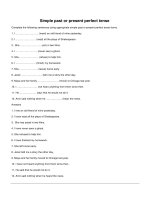Using the present perfect tense
Bạn đang xem bản rút gọn của tài liệu. Xem và tải ngay bản đầy đủ của tài liệu tại đây (12.96 KB, 1 trang )
Using the present perfect tense
Form: has / have + past participle form of the verb
Affirmative Negative Question
I have worked. I have not worked. Have I worked?
He has worked. He has not worked. Has he worked?
She has worked. She has not worked. Has she worked?
They have worked. They have not worked. Have they worked?
We have worked. We have not worked. Have we worked?
You have worked. You have not worked. Have you worked?
Notes
Use
have
when the subject is a plural noun or plural pronoun like
you, we
and
they
. Have is also used with the
first person singular pronoun
I.
Use
has
when the subject is a singular noun or a singular pronoun like
he, she
or
it.
Uses of the present perfect tense
The present perfect tense is used to talk about a finished action or event that is connected with the present in
some way.
If we say that somebody has done something, we are thinking about the past and the present at the same time. In
many cases it is possible to change a present perfect sentence into a simple present sentence.
She
has finished
her job. (= Her job is now finished.)
I
have broken
my leg. (= My leg is broken now.)
John
has broken
another window. (= Another window is broken now.)
The boys
have set
the bird free. (= The bird is free now.)
His father
has died
. (= His father is dead.)
The present perfect tense is often used to express the idea of completion or achievement.
She
has written
five novels.
The boy
has done
his homework.
I
have cleaned
the doors and windows.
Giving news of recent events
The present perfect tense is the most normal tense for giving news of recent events.
The rupee
has fallen
against the dollar.
The opposition
has said
that the government’s economic policies are not working.
There
has been
an explosion near the Juma Masjid.
Be first to know when grammar rules change! Sign up to our newsletter here: englishgrammar.org (It's free)
Powered by TCPDF (www.tcpdf.org)









